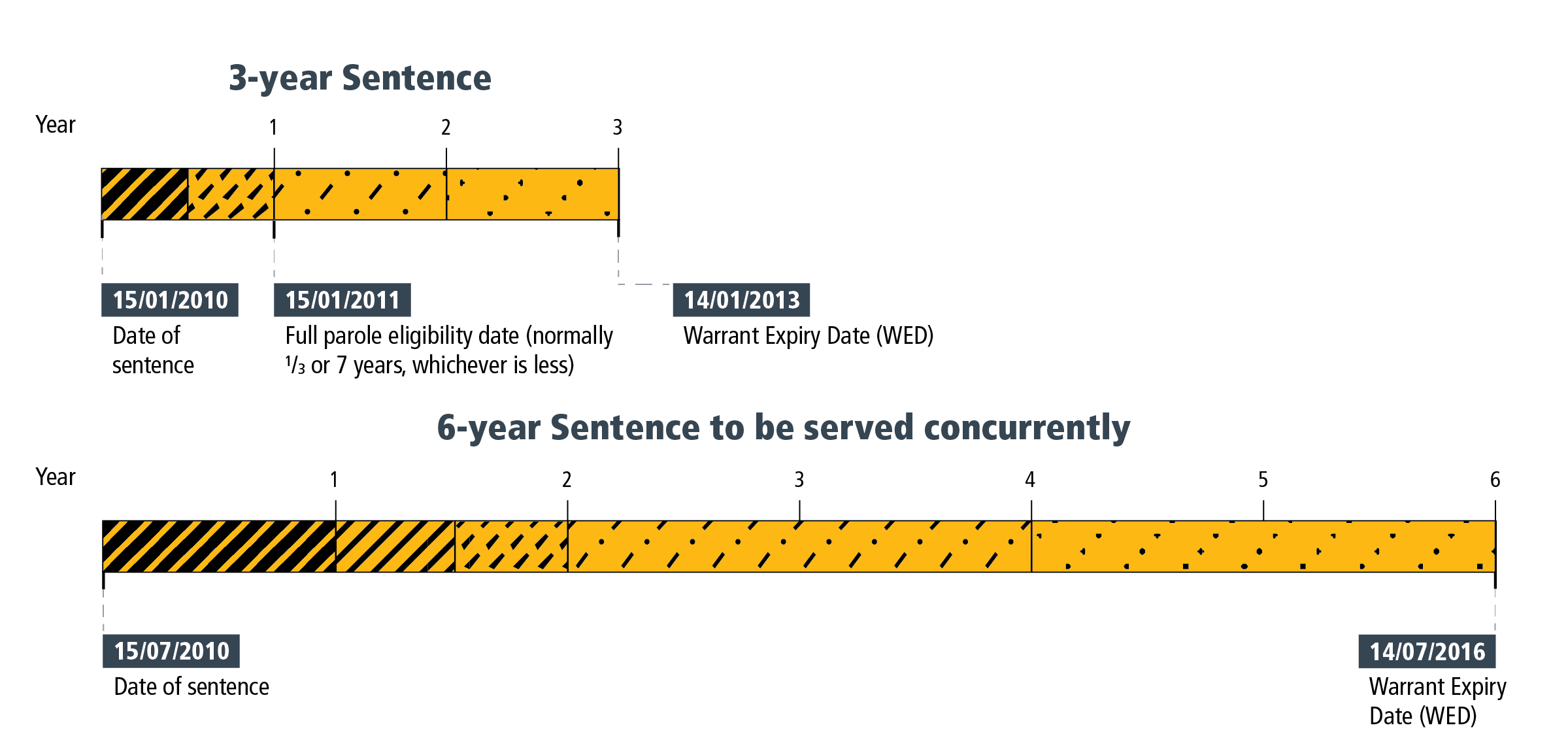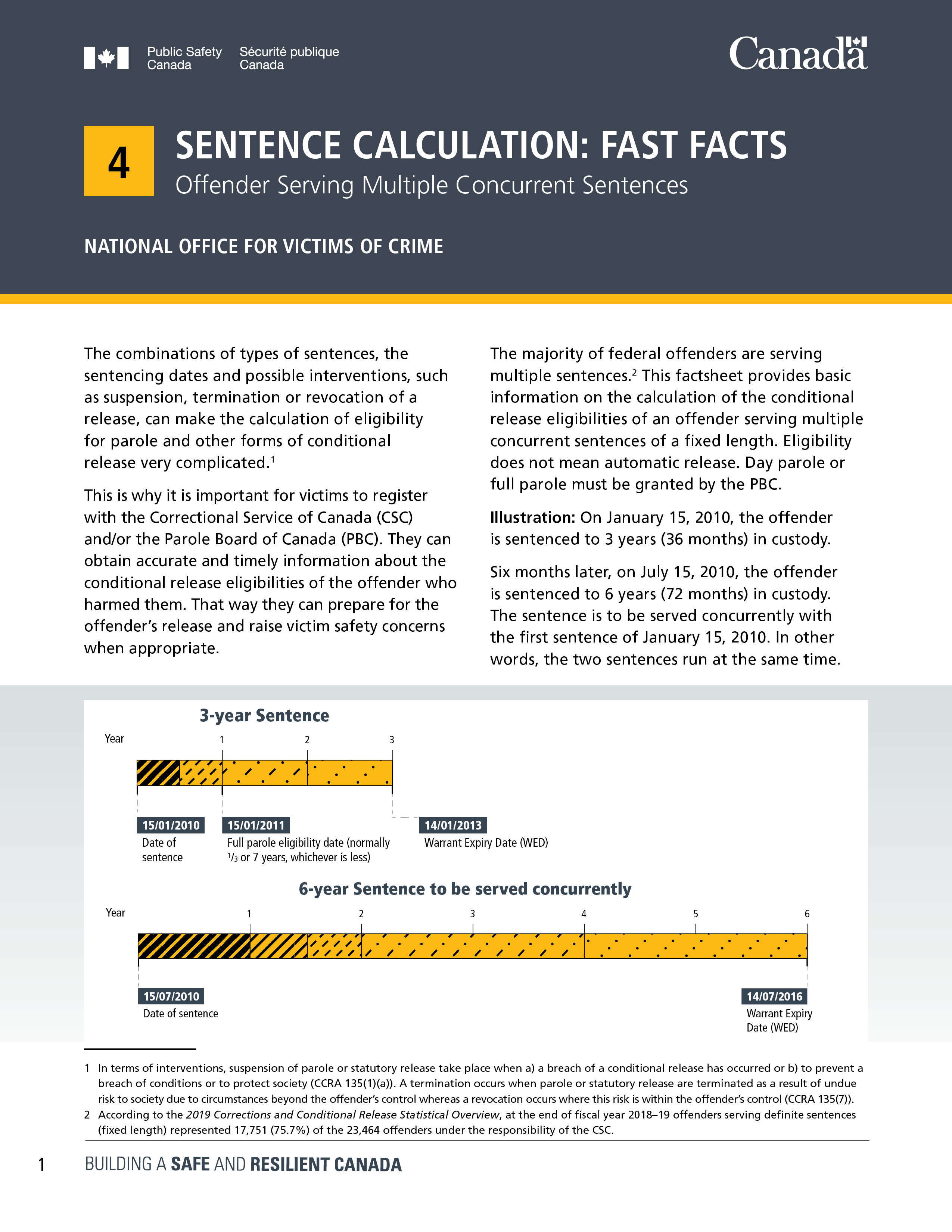Sentence Calculation: Fast Facts: Offender Serving Multiple Concurrent Sentences
National Office for Victims of Crime
The combinations of types of sentences, the sentencing dates and possible inte rventions, such as suspension, termination or revocation of a release, can make the calculation of eligibility for parole and other forms of conditional release very complicated.Footnote 1
This is why it is important for victims to register with the Correctional Service of Canada (CSC) and/or the Parole Board of Canada (PBC). They can obtain accurate and timely information about the conditional release eligibilities of the offender who harmed them. That way they can prepare for the offender’s release and raise victim safety concerns when appropriate.
The majority of federal offenders are serving multiple sentences.Footnote 2 This factsheet provides basic information on the calculation of the conditional release eligibilities of an offender serving multiple concurrent sentences of a fixed length. Eligibility does not mean automatic release. Day parole or full parole must be granted by the PBC.
Illustration: On January 15, 2010, the offender is sentenced to 3 years (36 months) in custody.
Six months later, on July 15, 2010, the offender is sentenced to 6 years (72 months) in custody. The sentence is to be served concurrently with the first sentence of January 15, 2010. In other words, the two sentences run at the same time.

Image description
This timeline illustrates a six year concurrent sentence. The concurrent sentence begins on July 15th, 2010 and lasts six years until the warrant expiry date on July 14th, 2016.
- This timeline illustrates a three year sentence, and the eligibility date for full parole.
- The sentence begins on January 15th, 2010, and lasts three years until the warrant expiry date, on January 14th, 2013.
- The eligibility date for full parole is January 15th, 2011. This is one year into the sentence. This date is one third of the sentence or seven years, whichever is less.
Combining Sentences
Under subsection 139(1) of the Corrections and Conditional Release Act (CCRA), the first and second sentences are combined into one sentence. The combined sentence begins on the start date of the first sentence (January 15, 2010) and ends on the expiration date of the second sentence (July 14, 2016). In this case, both sentences combined result in a sentence of 6 years and 6 months.

Image description
- This timeline illustrates a total combined sentence of six years and six months, and the eligibility date for full parole.
- The sentence begins on January 15th, 2010, and lasts six years and six months until the warrant expiry date on July 14th, 2016.
- The eligibility date for full parole is March 16th, 2012. This date is one third or seven years of the sentence, whichever is less.
Full Parole Eligibility
Under subsection 120.2(1) of the CCRA, the full parole (FP) eligibility of the concurrent (combined) sentences is the later of the following two dates:
- the FP eligibility date on the first 3-year sentence only, and
- the FP eligibility date of the combined sentence.
In this case, the FP eligibility date of the first 3-year sentence is January 15, 2011. It is 1 year after the start of the sentence (1/3 of the 3 years). The FP eligibility date of the combined sentence of 6 years and 6 months is 2 years and 2 months (1/3 of 6 years and 6 months) after the start of the sentence. In this case, it is the FP eligibility date of the combined sentence, March 16, 2012, that is the later of the two dates. Eligibility does not mean automatic release. Full parole must be granted by the PBC.

Image description
- This timeline illustrates a total combined sentence of six years and six months, and the eligibility date for full parole.
- The sentence begins on January 15th, 2010, and lasts six years and six months until the warrant expiry date on July 14th, 2016.
- The eligibility date for full parole is March 16th, 2012. This date is one third or seven years of the sentence, whichever is less.
Eligibility for Temporary Absences, Work Release, Day Parole and Statutory Release
Escorted temporary absence (ETA): Under subsection 17 of the CCRA, an offender serving a fixed sentence may be granted an ETA at any time. This is the case in this example.
Unescorted temporary absence (UTA): Under paragraph 115(1)(c) of the CCRA, an offender serving a fixed sentence is eligible for a UTA after serving 6 months or ½ of the offender’s full parole eligibility date, whichever is later. In this case, the later UTA eligibility is February 14, 2011. It is 1 year and 1 month after the start of the combined sentence.
Work release: Under subsection 18(2) of the CCRA, an offender is eligible for work release at the same date they are eligible for a UTA. In this case, the work release eligibility date is February 14, 2011.
Day Parole (DP): Under paragraph 119(1)(c) of the CCRA, an offender serving a fixed sentence is eligible for day parole after serving 6 months or 6 months before full parole eligibility, whichever date is later. In this case, the later DP eligibility date is September 15, 2011. That means 20 months after the start of the combined sentence.
Statutory Release (SR): Under section 127 of the CCRA, an offender is entitled to statutory release after serving 2/3 of their combined sentence of 6 years and 6 months, which began on January 15, 2010. In this case, the SR date is May 15, 2014.
N.B. These rules establish the earliest possible eligibility date for ETAs, UTAs, work release, DP, full parole and statutory release. Eligibility does not mean automatic release. Only SR is an entitlement that the PBC can prohibit with a detention order. These conditional releases must be granted by the appropriate authority.

Image description
- This timeline illustrates a total combined sentence of 6 years and 6 months, and the eligibility dates for an escorted temporary absence, an unescorted temporary absence, work release, day parole, full parole, the statutory release date and the warrant expiry date.
- The sentence begins on January 15th, 2010, and lasts 6 years and 6 months until the warrant expiry date on July 14th, 2016.
- The eligibility date for an escorted temporary absence (ETA) is anytime during the sentence. In this case, the eligibility date for an ETA is January 15th, 2010.
- The eligibility date for an unescorted temporary absence and work release is February 14th, 2011. This date is one sixth or six months of the sentence, whichever is later.
- The eligibility date for day parole (DP) is on September 16th, 2011. This date is six months before full parole eligibility date or six months of the sentence, whichever is later.
- The eligibility date for full parole is March 15th, 2021. This date is one third of the sentence or seven years, whichever is less.
- The statutory release date is May 16th, 2014. This date is two thirds of a sentence.
- Date modified:
